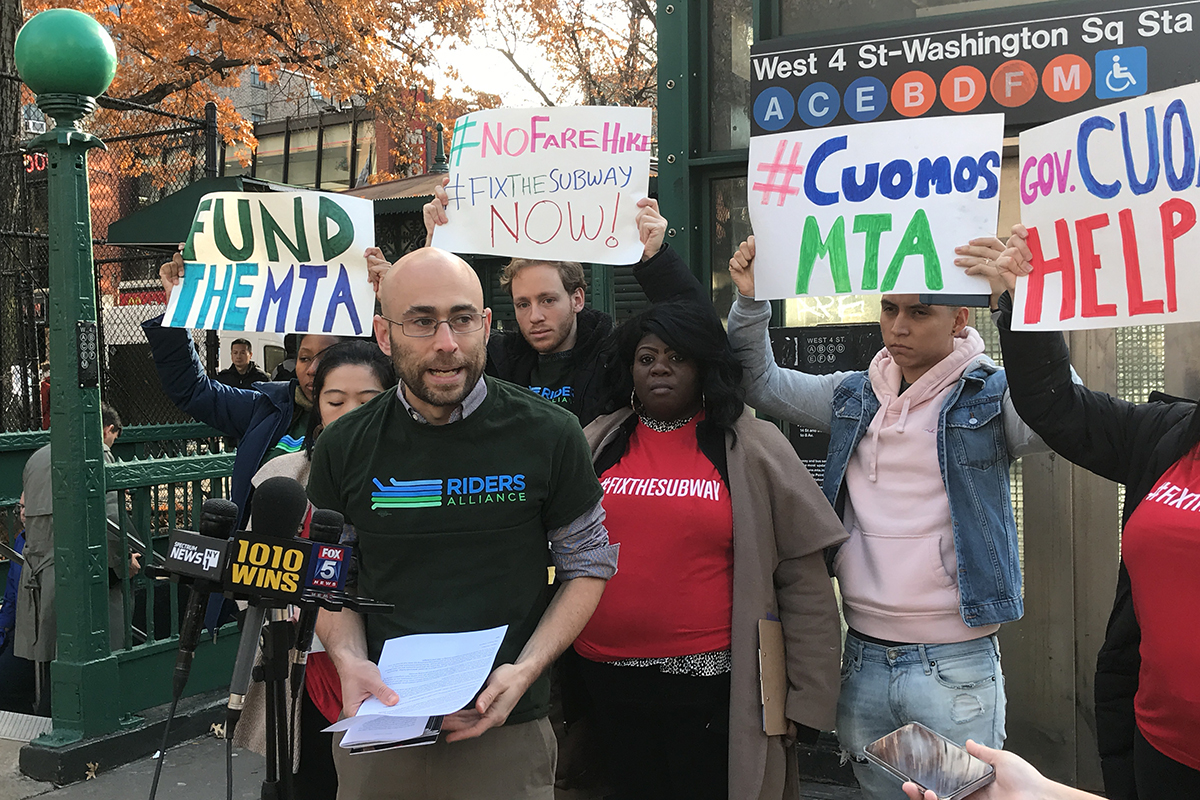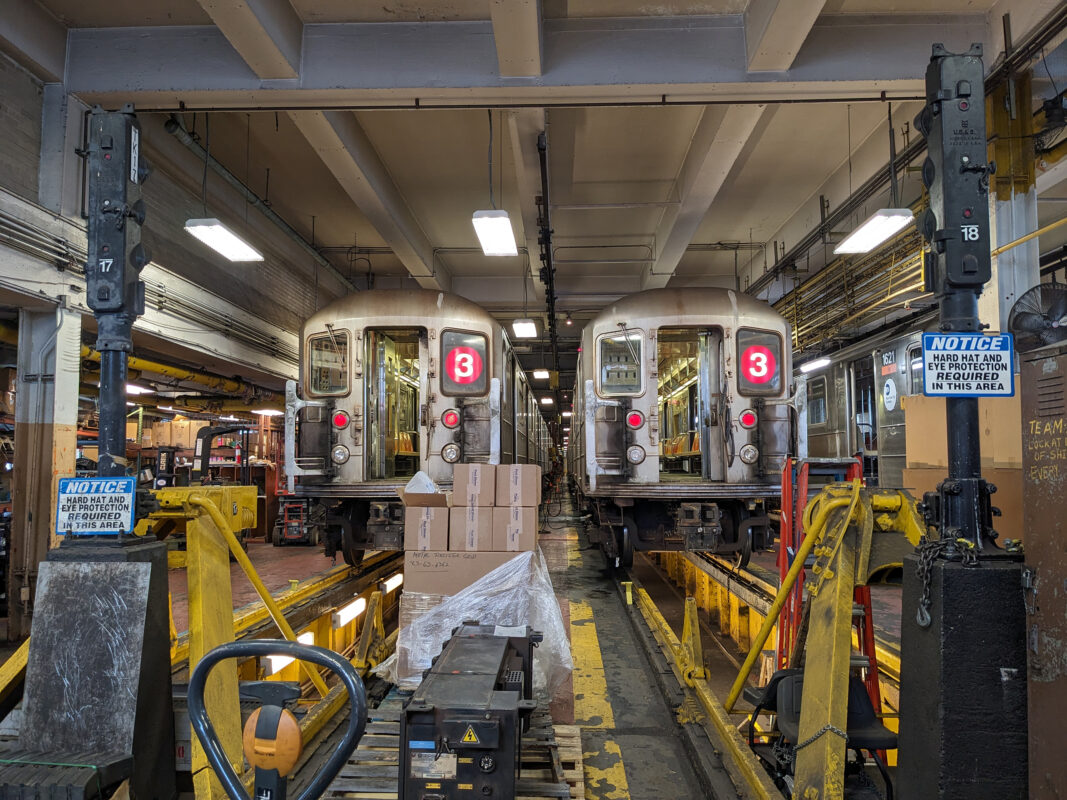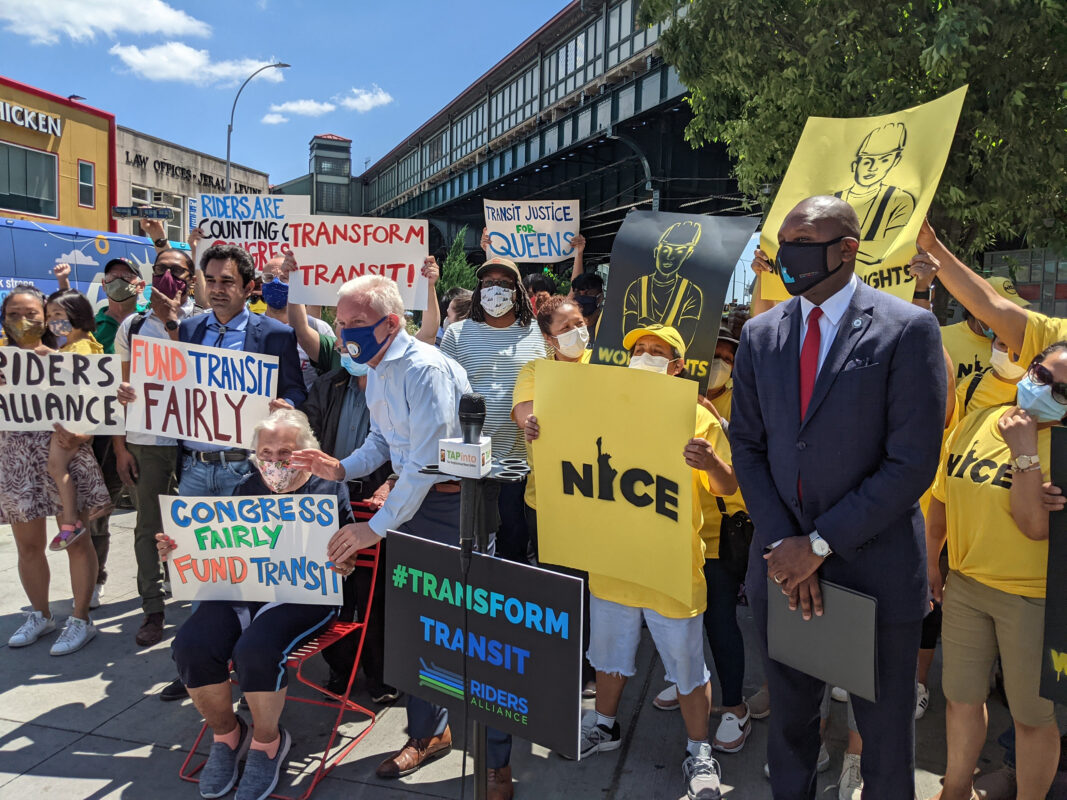
Danny Pearlstein spends his days fighting for better transit for New Yorkers. As Policy and Communications Director at Riders Alliance, he helps catalyze the 1000+ member-strong organization to demand fast, frequent, reliable subway and bus service. He also is a member of the Resilient Commutes working group for this year’s Rewire program. Read his full bio below.
I sat down with Danny to talk about his journey to this work, why designers should care about transit, and how reliable subway and bus service can act as a powerful engine of equity.
–Hadley Stack
HS: What do you do for a living?
Danny Pearlstein: I am the Policy and Communications Director at the Riders Alliance. We’re a grassroots organization of subway and bus riders. We fight for better public transit for millions of people who depend on it, and for the more just and equitable city that we know it will create. We have a community organizing model, and I support that with publicity, strategy and advocacy with our members, elected officials, members of the media and our coalition partners at the city, the state and occasionally at the federal level.
Is there something that you think the public gets wrong about public transit?
DP: Our work is premised on the idea that the riding public knows best about public transit. Approaching it from the opposite direction, we hear a lot of grumbling from the elite, the powers that be, about public transit. They’ll talk about how dirty it is; they’ll talk about how much fare evasion there is – problems which, of course, are the fault of the people on public transit. If you don’t ride transit, you can’t evade the fare, conveniently. And we push back on the narrative. Our argument is that the powerful people, institutions and our elected leadership are responsible for the quality of public transit, not the millions of riders.
Transit affordability is a big focus of ours, but we also focus a lot on the quality of service because we believe that fast, frequent, reliable transit is one of the best engines of equity a city can have. It provides people time – that most precious commodity. We sometimes think about how people who have a higher hourly wage will say their time is more valuable. But actually, it’s the opposite. Low income people, who are especially dependent on public transit, can’t pay other people to take care of other things in their lives when transit eats too much of their time. We need fast, frequent, reliable subway and bus service so that New Yorkers have access to everything the city has to offer in the shortest distance and time.

Why should people who love New York care about this work?
DP: Public transit makes cities possible and it makes density possible. It is also a core public space. Just the same way our parks, our museums and our libraries are premier public spaces, so is the transit system. In New York, our subway is probably the most iconic public space we have. I often think about those orange and yellow seats from the trains that were purchased in the 70s and 80s: around the world those are identifiable as the New York City subway. They’ve come to represent not just the subway but the City of New York. That’s why people identify with the transit system.
I know that a lot of Forum Fellows are interested in the fight for world class transit. What is one thing that they can do to help in this effort?
DP: It’s been especially hard to pursue change, because the transit system is, by design, insulated from the political and democratic process. It’s governed by the Metropolitan Transportation Authority, the MTA, and no one knows what that is, but everyone knows that they hate it. Politicians gain so much from the fact that the MTA exists, because they can blame the MTA for the problems with a basic public service that all New Yorkers depend on.
What we have done is bring riders together as an organized voice, and also identify who the agents of change are. If we want better subway service, the governor of New York has to fund it, because the governor controls the MTA. And if we want better bus service, the mayor of New York has to be willing to prioritize equity on our streets and reallocate scarce public space, so that bus riders and bus operators get the respect we deserve, and buses can move quickly and reliably.
So, I think probably the short answer to your question is to join together. It doesn’t have to be under the Riders Alliance umbrella, but it has to be together because lone voices don’t accomplish very much. Community organizing works because together, people power works.

If you could wave a wand and make one magical change to the transit system in New York City, what would it be?
DP: The through line of my experience of transit is a sort of a contradiction: I love being in transit, but I also want it to get me where I’m going as quickly as possible. I think that that’s certainly most people’s experience of transit. We both love it and want to leave it. So I’d think about how the subway can be faster; how the bus can be faster.
Is there a global city that you think makes an interesting model for buses in New York?
DP: Latin American cities are famous for their bus service. And there are certainly other places around the world that have really dramatically improved bus service. Lately, though, I’ve been thinking of upstate New York cities a lot. Albany has posted some very significant gains for its own bus service. Buffalo just got a big grant for better bus service. There’s exciting stuff going on with buses upstate.

How can we make expanding transit more affordable in New York?
DP: When everyone involved in a project sees how high transit costs are, everyone involved tries to make the most of that project out of the fear that there isn’t going to be another one. It’s simply too expensive. The way to bring costs down is to spend more and to do more with what we spend so that we can be continuously developing the way European and East Asian cities do. We have to build our muscle memories and refine processes that make things more efficient. The reason our competitors are eating our lunch, so to speak, when it comes to transit costs, is because they are more, rather than less, ambitious than we are.
You’re currently participating in one of our Rewire working groups. What have you learned from your fellow working group members?
DP: My Rewire group met up today for a site visit of transit on Utica Avenue. It’s so much fun to be working with planners, designers and engineers. I normally work with organizers, communications professionals, journalists and lawyers. It’s so much fun to be working with people in design professions, who have this depth of excitement about the fabric of the city itself, which is something that I have casual acquaintance with. I was talking to one of my fellow Fellows today who spent a part of the pandemic doing a massive research project on street names in Brooklyn. My teammates know so much, and they notice so much. It was a very richly textured experience.

What is something you think our Fellows would be surprised to learn about you?
DP: If I weren’t working in transportation right now, I think I would want to work somehow in food. I spend a lot of time cooking and eating and preparing food for my family. In addition to moving the city in a more transit-dependent direction, we also need to lean more into the green city that we have been and need to become. And that to me starts in the kitchen.
I’d love to hear what your perfect day in New York City looks like.
DP: I’d try to take in many different modes of transportation. My perfect day would incorporate cycling, walking, certainly the bus and the train, and ideally, some time spent on the water. One of the most fun things I’ve done in the last few years was kayaking around the city with the Inwood Canoe Club. We were kayaking right along the eastern shore of the Hudson River, next to the Metro North tracks. I was admiring the trains going by, while paddling with the current of the river. That was very, very special. Also, it would ideally be a day that gets me out to the beach. The fact that we can go to the beach on the subway is one of the many things that makes this a very special place.
This interview was edited and condensed for clarity.
All images courtesy of Danny Pearlstein
Danny Pearlstein is Policy & Communications Director at the Riders Alliance, New York’s grassroots organization of subway and bus riders. He started advocating for better public transit in high school and has worked as an urban planner, a City Council staffer, and a lawyer representing injured workers and low-income tenants.